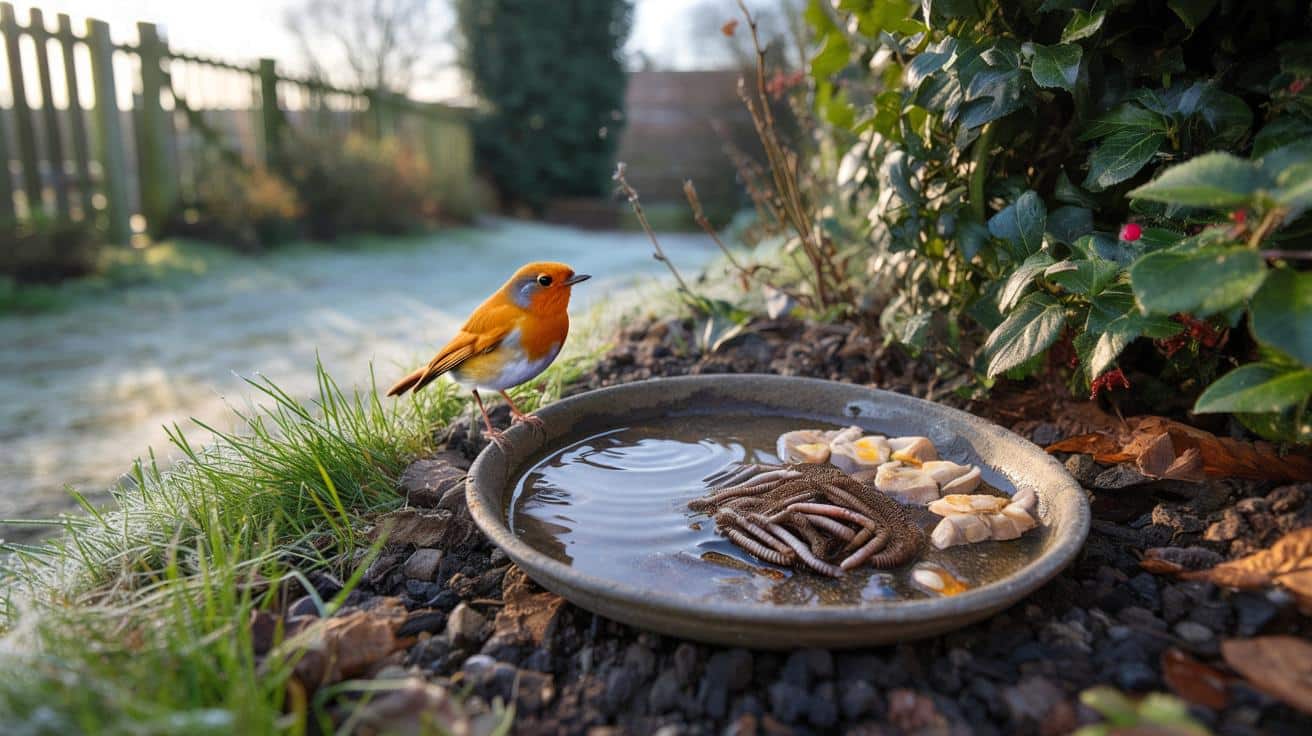Fewer insects, stingier lawns, harsher snaps of weather. Your patch of green can change that by tonight.
I notice it first thing, before the kettle clicks. A small copper chest bobs at the fence, eyes like pinheads, checking the bare soil where last year’s tomato pots stood. The robin waits for a beetle that doesn’t show, then flicks to the water dish and back again, pausing as if weighing up the odds. Across the street, two driveways replaced front gardens this spring, all hard edges and nowhere to forage. The street feels tidier, quieter, thinner somehow. We’ve all had that moment when a wild thing looks at us like we hold the next move. I slide open the back door, breath fogging, and tip a handful of soaked mealworms onto a shallow tray. The robin lands before the dish stops rocking. His head cocks. Something in the air shifts.
Why robins are going hungry now
Robins hunt by sight, scanning low turf, leaf litter and soft soil for tiny lives that wriggle. They need protein through the cold months and even more during spring broods. When lawns toughen, borders are bark-mulched to the inch, and edges get strimmed flat, the menu shrinks overnight. Add a week of hard frost or a summer of bone-dry soil and worms retreat deeper than that slender bill can reach.
Look at the pattern across Europe and you see the bigger picture. A long-term German study recorded a roughly 75% drop in flying insect biomass in nature reserves over 27 years. In the UK, observers in the RSPB’s Big Garden Birdwatch often note robins yo-yoing with weather extremes, steady some years, thin on the ground the next. One mild winter won’t fix a hungry spring, and a hot spell can snap the chain between aphids, caterpillars and the soft beaks waiting in a nest.
Strip away insects and you strip away choice. Robins will still visit, but they burn energy searching wider, chasing territory disputes they didn’t ask for. A bird that needs to feed chicks every 10 to 20 minutes can’t afford empty ground. Put simply: if your garden is locked down — sealed edges, plastic grass, pesticides — it’s a dining room with no door. You can open it again with a few quiet changes.
Turn your garden into a robin canteen
Start with food that actually fits a robin’s bill. Offer live or soaked dried mealworms on a low tray, add sunflower hearts, small suet pellets, and the odd chopped sultana or soft berry. Keep it close to cover — a rose, holly or a dense shrub — so the bird can dive for safety between bites. A shallow water dish, no deeper than a couple of centimetres at the edge, is a lifeline for drinking and feather care.
Rotate where you scatter food so you don’t create a messy, disease-prone patch under one perch. Rinse feeders and trays weekly with hot soapy water, then dry in the sun. Let’s be honest: nobody does this every day. Do it most weekends and you’re miles ahead. In spring, lean harder on protein and lighter on fat; whole peanuts and big chunks can choke chicks, so crush or skip them until fledging’s done.
Think buffet plus habitat, not just buffet. Replace one strip of bark mulch with leaf litter and a little compost so beetles and worms move back in. Plant native structure — hawthorn, holly, hazel, ivy — and let a corner stay “untidy” so spiders and grubs set up shop. Five square feet of mess can feed a family of birds.
“I put mealworms out before the school run, and a robin appears within minutes. When I forget, the garden feels strangely empty.”
- Quick win: low tray by a dense shrub, mealworms soaked for 10 minutes.
- No-spray pledge: skip pesticides; they wipe out the very food robins need.
- Water, always: a shallow dish with a pebble slope for safe footing.
- Plant for insects: hawthorn hedge, ivy tangle, oxeye daisy in sunny spots.
- Night routine: bring in leftover food to deter rats and foxes.
Small mistakes that cost robins — and simple fixes
We polish gardens into showrooms and then wonder where the birds went. Plastic grass looks tidy but it starves the soil, so nothing wriggles underneath. Netting draped over fruit can snag a small bird by the foot; if you must use it, keep it taut and mesh size small. A cat on silent paws turns a feeding spot into an ambush, so place trays where shrubs and thorny cover offer a split-second escape.
Bread is filler, not fuel. Milk is a no. Grated cheese crops up in old tips, but salt is a risk and it molds fast on damp days. Better to focus on the good stuff: fresh or soaked mealworms, sunflower hearts, tiny suet pieces, chopped soft fruit, and crushed unsalted peanuts outside the chick season. Keep an eye on the weather; when frost bites, double the fat sources, and when rain lashes for days, keep food under a little roof so it stays edible.
There’s a difference between feeding and building a food web. If you can, loosen a square metre of compacted flowerbed and mix in garden compost so the soil breathes. Plant nectar through the seasons — snowdrops, hellebore, lungwort, then foxglove and lavender — so caterpillars and midges follow. **No insect spray, no moss killer, no blue slug pellets.** Try wool pellets or beer traps for slugs, or learn to accept nibbled leaves as a sign the system’s alive. **A living mess beats a lifeless polish.** **Your robin will vote with his feet.**
The small changes that ripple out
Put food out today and a robin will likely find it by tea-time. Keep water fresh and you’ll see him bathe, then preen on the gate like he owns the street. Plant a hedge this winter and you’ll hear late-afternoon song by the first warm week of spring. These are small acts, barely an hour here and there, but they stack in a way that feels bigger than a bin bag of weeds.
Every road has one garden that starts the drift back to life. The neighbour sees the robin, then the wren, then the first ladybird on the window frame. Before long, people talk over fences about a clutch fledged near the compost bin. A robin doesn’t ask for much — safe corners, soft ground, clean water, a plate of protein when the weather swings. The rest is us deciding what kind of patch we want to wake up to tomorrow.
| Point clé | Détail | Intérêt pour le lecteur |
|---|---|---|
| Feed low, near cover | Tray with soaked mealworms, sunflower hearts, tiny suet by a dense shrub | Higher chance of a robin visit within hours, safer feeding |
| Grow the food web | Leaf litter, composted soil, native shrubs, no pesticides | More natural prey on site, less reliance on constant refills |
| Seasonal tweaks | More fat in freezes, more protein in spring, avoid big peanuts during nesting | Supports survival in tough spells and healthy broods |
FAQ :
- What should I feed robins right now?Live or soaked dried mealworms, sunflower hearts, small suet pellets, and chopped soft fruit. Offer on a low tray close to cover with a shallow water dish.
- Are dried mealworms safe?Yes, if softened. Soak for about 10 minutes so they’re easier to swallow and kinder on hydration, especially for chicks in spring.
- Where do I place the feeder?At ground level or a low platform within a quick hop of dense shrubs. Avoid exposed spots where predators can rush in.
- What garden plants help robins most?Native structure and year-round nectar: hawthorn, holly, ivy, hazel, plus oxeye daisy, foxglove and lavender to fuel insects they’ll hunt.
- How do I keep robins safe from cats?Site food near thorny cover, avoid ground feeding at dawn/dusk if cats roam, and ask cat owners about bell collars during breeding season.








Just put out soaked mealworms and a robin showed up in ten mintues—wild. Thanks for the super clear, do-it-today advice!
Is there solid evidence that garden feeding improves survival long-term, or are we creating dependency? Great piece, but I’d like links to studies.